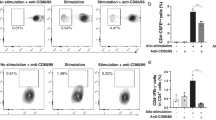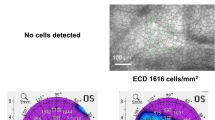Abstract
In this study, we explored the immunomodulatory effects of viral interleukin (IL) IL-10 after ex vivo and in vivo gene transfer in experimental corneal transplantation. Wistar–Furth rats were used as donors and major histocompatibility complex class I/II-disparate Lewis rats served as recipients. For ex vivo gene therapy donor corneas were either transfected with liposome/vIL-10 plasmid DNA mixtures or transduced with a vIL-10 expressing adenovirus vector (AdvIL-10). For in vivo studies, recipients were treated with AdvIL-10 intraperitoneally 1 day before transplantation. Graft survival was analysed using the Kaplan–Meier survival method. To monitor the efficacy of the therapy messenger RNA (mRNA) cytokine expression profiles in grafts and draining lymph nodes were analysed by quantitative real-time reverse transcription-polymerase chain reaction. Moreover, anti-adenovirus immunity was also investigated. Neither ex vivo liposome-mediated vIL-10 gene transfer nor ex vivo AdvIL-10 gene transfer led to prolonged corneal allograft survival. In contrast, corneal allograft survival was significantly prolonged in animals receiving systemic AdvIL-10 gene transfer. Moreover, only systemic vIL-10 gene therapy modulated the cytokine mRNA expression profile in draining lymph nodes. Interestingly, systemic AdvIL-10 gene transfer could not inhibit the generation of anti-adenovirus antibodies. Our data indicate systemic expression of the vIL-10 gene is required to modulate the cytokine expression profile in the draining lymph nodes, which might be a pre-requisite for the success of cytokine gene therapy.
This is a preview of subscription content, access via your institution
Access options
Subscribe to this journal
Receive 12 print issues and online access
$259.00 per year
only $21.58 per issue
Buy this article
- Purchase on Springer Link
- Instant access to full article PDF
Prices may be subject to local taxes which are calculated during checkout




Similar content being viewed by others
References
Williams KA, Muehlberg SM, Lewis RF, Coster DJ . Long-term outcome in corneal allotransplantation. The Australian Corneal Graft Registry. Transplant Proc 1997; 29: 983.
Pleyer U, Dannowski H, Volk HD, Ritter T . Corneal allograft rejection: current understanding. I. Immunobiology and basic mechanisms. Ophthalmologica 2001; 215: 254–262.
George AJ, Larkin DF . Corneal transplantation: the forgotten graft. Am J Transplant 2004; 4: 678–685.
Torres PF, De Vos AF, van der Gaag R, Martins B, Kijlstra A . Cytokine mRNA expression during experimental corneal allograft rejection. Exp Eye Res 1996; 63: 453–461.
Sano Y, Osawa H, Sotozono C, Kinoshita S . Cytokine expression during orthotopic corneal allograft rejection in mice. Invest Ophthalmol Vis Sci 1998; 39: 1953–1957.
Yamada J, Yoshida M, Taylor AW, Streilein JW . Mice with Th2-biased immune systems accept orthotopic corneal allografts placed in ‘high risk’ eyes. J Immunol 1999; 162: 5247–5255.
King WJ, Comer RM, Hudde T, Larkin DF, George AJ . Cytokine and chemokine expression kinetics after corneal transplantation. Transplantation 2000; 70: 1225–1233.
Moore KW, de Waal Malefyt R, Coffman RL, O'Garra A . Interleukin-10 and the interleukin-10 receptor. Annu Rev Immunol 2001; 19: 683–765.
de Waal Malefyt R, Abrams J, Bennett B, Figdor CG, de Vries JE . Interleukin 10(IL-10) inhibits cytokine synthesis by human monocytes: an autoregulatory role of IL-10 produced by monocytes. J Exp Med 1991; 174: 1209–1220.
de Waal Malefyt R, Haanen J, Spits H, Roncarolo MG, te Velde A, Figdor C et al. Interleukin 10 (IL-10) and viral IL-10 strongly reduce antigen-specific human T cell proliferation by diminishing the antigen-presenting capacity of monocytes via downregulation of class II major histocompatibility complex expression. J Exp Med 1991; 174: 915–924.
Ralph P, Nakoinz I, Sampson-Johannes A, Fong S, Lowe D, Min HY et al. IL-10, T lymphocyte inhibitor of human blood cell production of IL-1 and tumor necrosis factor. J Immunol 1992; 148: 808–814.
Cassatella MA, Meda L, Bonora S, Ceska M, Constantin G . Interleukin 10 (IL-10) inhibits the release of proinflammatory cytokines from human polymorphonuclear leukocytes. Evidence for an autocrine role of tumor necrosis factor and IL-1 beta in mediating the production of IL-8 triggered by lipopolysaccharide. J Exp Med 1993; 178: 2207–2211.
Qin L, Ding Y, Pahud DR, Robson ND, Shaked A, Bromberg JS . Adenovirus-mediated gene transfer of viral interleukin-10 inhibits the immune response to both alloantigen and adenoviral antigen. Hum Gene Ther 1997; 8: 1365–1374.
Ding Y, Qin L, Kotenko SV, Pestka S, Bromberg JS . A single amino acid determines the immunostimulatory activity of interleukin 10. J Exp Med 2000; 191: 213–224.
David A, Chetritt J, Guillot C, Tesson L, Heslan JM, Cuturi MC et al. Interleukin-10 produced by recombinant adenovirus prolongs survival of cardiac allografts in rats. Gene Therapy 2000; 7: 505–510.
Brauner R, Nonoyama M, Laks H, Drinkwater Jr DC, McCaffery S, Drake T et al. Intracoronary adenovirus-mediated transfer of immunosuppressive cytokine genes prolongs allograft survival. J Thorac Cardiovasc Surg 1997; 114: 923–933.
DeBruyne LA, Li K, Chan SY, Qin L, Bishop DK, Bromberg JS . Lipid-mediated gene transfer of viral IL-10 prolongs vascularized cardiac allograft survival by inhibiting donor-specific cellular and humoral immune responses. Gene Therapy 1998; 5: 1079–1087.
Klebe S, Sykes PJ, Coster DJ, Krishnan R, Williams KA . Prolongation of sheep corneal allograft survival by ex vivo transfer of the gene encoding interleukin-10. Transplantation 2001; 71: 1214–1220.
Bertelmann E, Ritter T, Vogt K, Reszka R, Hartmann C, Pleyer U . Efficiency of cytokine gene transfer in corneal endothelial cells and organ-cultured corneas mediated by liposomal vehicles and recombinant adenovirus. Ophthalmic Res 2003; 35: 117–124.
Pleyer U, Dannowski H . Delivery of genes via liposomes to corneal endothelial cells. Drug News Perspect 2002; 15: 283–289.
Yang Y, Li Q, Ertl HC, Wilson JM . Cellular and humoral immune responses to viral antigens create barriers to lung-directed gene therapy with recombinant adenoviruses. J Virol 1995; 69: 2004–2015.
Kay MA, Glorioso JC, Naldini L . Viral vectors for gene therapy: the art of turning infectious agents into vehicles of therapeutics. Nat Med 2001; 7: 33–40.
Ritter T, Lehmann M, Volk HD . Improvements in gene therapy: averting the immune response to adenoviral vectors. BioDrugs 2002; 16: 3–10.
Pleyer U, Bertelmann E, Rieck P, Hartmann C, Volk HD, Ritter T . Survival of corneal allografts following adenovirus-mediated gene transfer of interleukin-4. Graefes Arch Clin Exp Ophthalmol 2000; 238: 531–536.
Comer RM, King WJ, Ardjomand N, Theoharis S, George AJ, Larkin DF . Effect of administration of CTLA4-Ig as protein or cDNA on corneal allograft survival. Invest Ophthalmol Vis Sci 2002; 43: 1095–1103.
Gong N, Pleyer U, Yang J, Vogt K, Hill M, Anegon I et al. Influence of local and systemic CTLA4Ig gene transfer on corneal allograft survival. J Gene Med 2006; 8: 459–467.
Konig Merediz SA, Zhang EP, Wittig B, Hoffmann F . Ballistic transfer of minimalistic immunologically defined expression constructs for IL4 and CTLA4 into the corneal epithelium in mice after orthotopic corneal allograft transplantation. Graefes Arch Clin Exp Ophthalmol 2000; 238: 701–707.
Klebe S, Coster DJ, Sykes PJ, Swinburne S, Hallsworth P, Scheerlinck JP et al. Prolongation of sheep corneal allograft survival by transfer of the gene encoding ovine IL-12-p40 but not IL-4 to donor corneal endothelium. J Immunol 2005; 175: 2219–2226.
Pleyer U . Immunobiology and Prevention of Allograft Reaction after Experimental Keratoplasty. Aeolus Press: Buren, Netherlands, 1996, pp 22–23.
Ardjomand N, McAlister JC, Rogers NJ, Tan PH, George AJ, Larkin DF . Modulation of costimulation by CD28 and CD154 alters the kinetics and cellular characteristics of corneal allograft rejection. Invest Ophthalmol Vis Sci 2003; 44: 3899–3905.
Hamrah P, Liu Y, Zhang Q, Dana MR . The corneal stroma is endowed with a significant number of resident dendritic cells. Invest Ophthalmol Vis Sci 2003; 44: 581–589.
Zhu Z, Stevenson D, Ritter T, Schechter JE, Mircheff AK, Kaslow HR et al. Expression of IL-10 and TNF-inhibitor genes in lacrimal gland epithelial cells suppresses their ability to activate lymphocytes. Cornea 2002; 21: 210–214.
Kolls J, Peppel K, Silva M, Beutler B . Prolonged and effective blockade of tumor necrosis factor activity through adenovirus-mediated gene transfer. Proc Natl Acad Sci USA 1994; 91: 215–219.
Acknowledgements
We thank Katrin Vogt and Sabine Jyrch for technical assistance. In addition, the authors would like to thank Dr René de Waal Malefyt, DNAX, Palo Alto, CA, USA for providing the vIL-10 plasmid (pcDSRa-BCRF1). This work was supported in part by DFG (Pl 150/14-1).
Author information
Authors and Affiliations
Corresponding author
Rights and permissions
About this article
Cite this article
Gong, N., Pleyer, U., Volk, HD. et al. Effects of local and systemic viral interleukin-10 gene transfer on corneal allograft survival. Gene Ther 14, 484–490 (2007). https://doi.org/10.1038/sj.gt.3302884
Received:
Revised:
Accepted:
Published:
Issue Date:
DOI: https://doi.org/10.1038/sj.gt.3302884
Keywords
This article is cited by
-
The Effects of Anti-LAP Monoclonal Antibody Down-regulation of CD4+LAP+ T Cells on Allogeneic Corneal Transplantation in Mice
Scientific Reports (2018)
-
Update on the Management of High-Risk Penetrating Keratoplasty
Current Ophthalmology Reports (2017)
-
Prolongation of heart allograft survival after long-term expression of soluble MHC class I antigens and vIL-10 in the liver by AAV-plasmid-mediated gene transfer
Langenbeck's Archives of Surgery (2008)
-
The influence of inducible costimulator fusion protein (ICOSIg) gene transfer on corneal allograft survival
Graefe's Archive for Clinical and Experimental Ophthalmology (2007)



